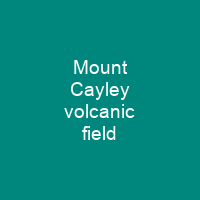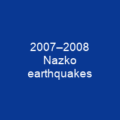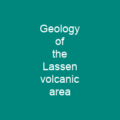The Mount Cayley volcanic field is a remote volcanic zone on the South Coast of British Columbia, Canada. Eruptions along the length of the field began between 1. 6 and 5. 3 million years ago. At least 23 eruptions have occurred throughout its eruptive history. There is evidence of a decline in volcanic activity over the last few million years. The most recent earthquake along the Cascadia subduction zone in the last 6,000 years recorded in 1700, was magnitude 9.0.
About Mount Cayley volcanic field in brief

The Cascade Volcanic Arc extends from Northern California to southwestern British Columbia. It forms a segment of the Garibaldi Volcanic Belt, the Canadian portion of the Cascade Volcanoic Arc, which extends from the Pacific Northwest to the British Columbia Coast. The central portion contains at least five volcanoes situated at the Powder Mountain Icefield. To the north, two volcanoes form a sparse area of volcanisms. Many of these volcanoes formed between 0. 01 and 1.6 million years ago, some of which show evidence of volcanic activity in thelast 10,000years. The Cascadian subduction zone is a 1,094 km long fault zone running 80 km off the Pacific Pacific coast. Unlike most subduction zones worldwide, there is no deep oceanic trench present along the continental margin in CASCadia. The reason is that the mouth of the Columbia River empties directly into the subduction Zone and deposits silt at the bottom of the Pacific Ocean, burying this large depression. Massive floods from prehistoric Glacial Lake Missoula during the Late Pleistocene also deposited large amounts of sediment into the trench. The fault zone is located on the Pacific coast of Canada and the United States and is about 1,000km north of Vancouver. It was formed as a result of the ongoing subduction of the Juan de Fuca Plate under the North American Plate at the Casadia Subduction zone along the British Coast.
You want to know more about Mount Cayley volcanic field?
This page is based on the article Mount Cayley volcanic field published in Wikipedia (as of Nov. 03, 2020) and was automatically summarized using artificial intelligence.







